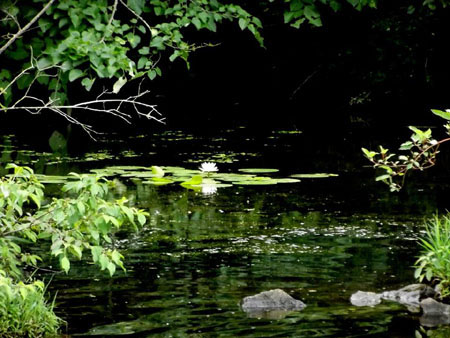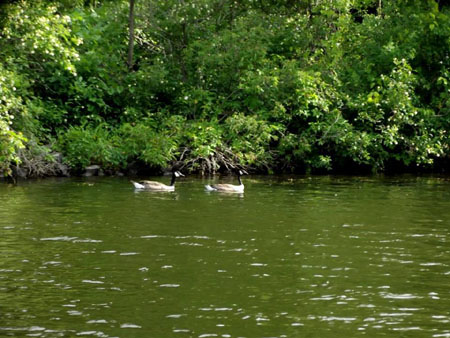Oneida Lake's Vital Wetlands
by Rebecca Schneider
Department of Natural Resources, Cornell University, Ithaca
and Edward L. Mills, Cornell Biological Field Station, Shackleton Point, Bridgeport

This map, dating from around 1930, was published in the Roosevelt Wildlife Annals series. Oneida Lake's extensive wetlands are indicated, east of Big Bay, and near Toad Harbor, Three Mile Bay, and Muskrat Bay. Note how the entire west side of Lower South Bay and the Long Point area, both highly prone to flooding today, were wetlands then.
The diverse and abundant wetlands distributed around Oneida Lake are a critical component of the lake and its watershed. A mosaic of small patches of mixed hemlock and hardwood swamps characterizes wetlands in the watershed's northern half. The watershed's southern portion and the countryside adjacent to Oneida Lake are dominated by several extensive wetlands.
Cicero Swamp is the largest of these and has deep, organic peat subsoils, deposited some 12,000 years ago as part of the postglacial Lake Iroquois. The Cicero Swamp includes a diversity of wetland types, from highbush blueberry bogs to red maple swamp forests, and a cattail-purple loosestrife marsh.
These wetlands are important wildlife habitats. Ducks and other waterfowl feed on aquatic insects in the shallow waters. The standing dead trees (what biologists call "snags") provide the required nesting locations for ospreys, wood ducks, and even an extensive heron colony in the Three Mile Bay State Game Management Area. Frogs, turtles, and snakes are a particularly rich animal component of the wetlands' biomes, and the Cicero Swamp is unique for harboring one of the last remaining populations of the native pygmy rattlesnake.
Oneida Lake's rich fish population is particularly dependent on the lake's inshore aquatic plant beds and its adjacent swamp forests for spawning and nursery areas. Juvenile fish can hide from predators in the dense thickets of plant stems and also find their essential aquatic insect food amidst this vegetation.

Photo provided by Margie Hastings
Oneida Lake's wetlands also exert a tremendous influence on the quantity and quality of water that flows from the watershed into the lake. Groundwater moves below the surface, from upland areas, carrying septic leachates, fertilizers, pesticides, and industrial wastes. Healthy lake-bordering wetlands intercept this groundwater before it reaches Oneida and its tributary streams. The dense complex of wetland plant roots, organic matter in the soil, and useful micro- organisms filters out many of the contaminants.
The extensive wetlands also provide a strong storage system for times when excessive rainfall floods streams and raises the lake's water level. Thick layers of soil litter (such as leaves) and organic matter absorb the rainwater like a sponge. Plant stems and foliage retard flowing water, reducing the flooding downstream. The dense network of roots, which bind the soil along stream banks and the lake's shore, minimizes erosion.
Human activities have impacted wetlands and wildlife within Oneida Lake's watershed. The Erie-Barge Canal, built around 1916, engendered dramatic changes in the timing and magnitude of lake level changes. More recently, manipulations of water levels during spring have been used to reduce property damage along the shore. Prior to the canal's construction, lake levels sometimes fluctuated over seven feet each year, but this has been considerably lessened. Inadvertently, canal lake-level management also eliminated spring flooding in some wetlands that were important fish spawning areas. These changes have contributed to a severe reduction in Oneida's chain pickerel and northern pike populations. In addition, wetlands are now less able to filter and store water. Many have been drained for agriculture and a considerable amount of low-lying areas along the lake have been filled for residential development.

Photo provided by Margie Hastings
Oneida Lake's shoreline aquatic vegetation has also changed dramatically. Water level manipulation is a standard practice for removal of aquatic plants and it has been effective in Oneida Lake. The winter's freezing of lake and wetland bottom sediments, combined with spring's ice scouring, effectively destroys pools of seeds and roots that are essential to maintain wetland environments.
Photographs and written records from the early 1900's document the existence of dense stands of emergent vegetation along much of Oneida's shore. More than forty shoreline and aquatic plant species were present around Sylvan Beach in 1916. Today, one would be hard pressed to find half that number. In the lake's bays, bulrush and water willows flourished 500 to 900 feet from land. By 1967, the stands of these plants were sparse, and only remnants of the vast beds exist today (primarily near Frenchman's and Dunham's Islands).
Currently, exotic plant species are invading and displacing native wetland vegetation, posing yet another threat to these vital areas. Purple loosestrife, the most visible invader, creates an attractive background in autumn, but its dense vegetation has a low value for wildlife. Although less obvious, giant reed grass and Japanese knotweed are also displacing the more valuable, native wetland plants. These exotic newcomers have highly competitive root systems and very successful seed dispersal mechanisms. These plants' impact on wetland communities' vitality is yet to be determined, but their presence is cause for alarm.
Protecting wetlands must be a long-term management goal for the Oneida Lake watershed. The lake is the vital, productive heart of this system. Its biological, economic, and aesthetic values cannot be understated, and the wetlands that surround it are the key to its continued health. Wetland losses during this century have reduced Oneida's watershed's storage and filtering potential and its usefulness for fish and other wildlife. The remaining wetlands must be managed with extreme caution and care.
Some efforts are underway. Through the Federal Government's Wetlands Protection Program, in cooperation with the USDA's Natural Resource Conservation Service, the U.S. Fish and Wildlife Service, and the Great Swamp Conservancy, 4000 to 6000 acres of wetlands south of Oneida Lake will be set aside and preserved. This local effort has the highest private owner participation rate in the entire United States' Wetlands Protection Program. Elsewhere, management must continue to address several key issues. The benefits of new commercial and residential development have to be weighed against the environmental depredations brought on by further wetland losses. Lake-level management needs to be reevaluated and focused on the fact that current water levels must be maintained to preserve the Oneida Lake environment. The quantity and quality of groundwater must be carefully guarded. Finally, the spread of invasive species has to be evaluated and, where possible, limited.
Simply put, it is time to stop the filling, ban the draining, keep the lake's level at the status quo, preserve existing wetlands, and restore as many others as possible. With careful management, Oneida Lake and its wetlands will continue to be a rich and productive ecosystem.

